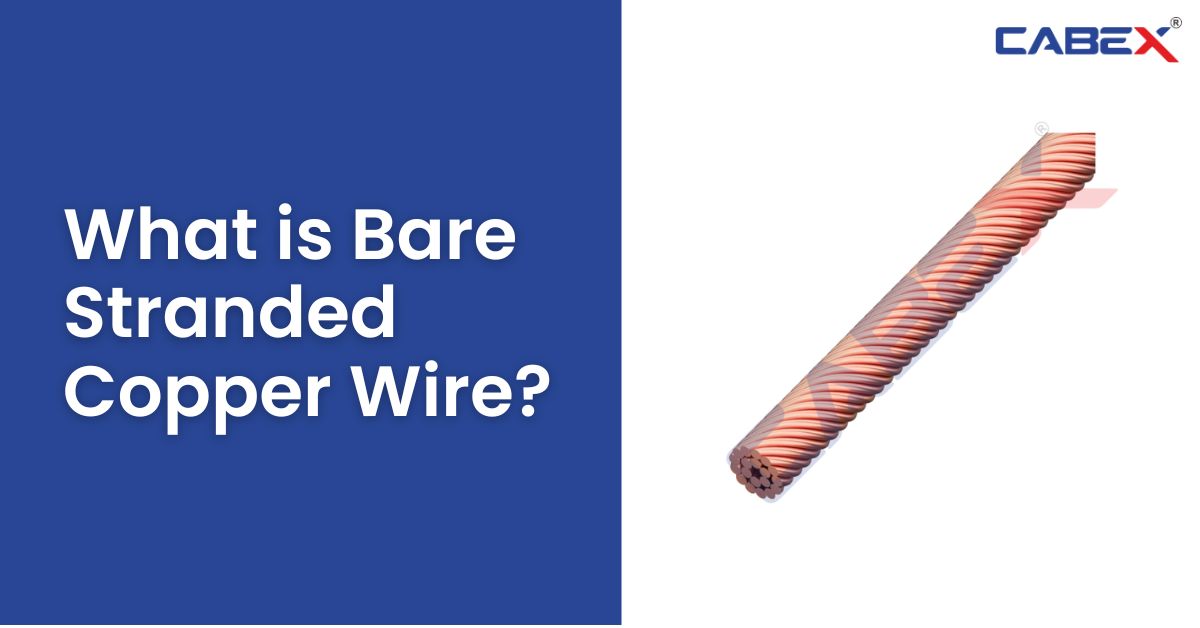In the realm of electrical engineering, Bare Stranded Copper Wire stands as a foundational and indispensable element. This type of wire, known for its exceptional conductivity and versatility, plays a pivotal role in various applications across different industries. From power transmission to telecommunications, and from electronics to renewable energy, bare stranded copper wire has earned its place as a preferred choice for professionals seeking reliable and efficient electrical conductors.
Understanding Bare Stranded Copper Wire
Bare Stranded Copper Wire, as the name suggests, is composed of pure copper strands that are tightly woven together to form a cohesive and flexible conductor. Each individual strand is meticulously engineered to enhance the overall conductivity and flexibility of the wire. By amalgamating multiple strands, this type of wire gains an edge over solid copper wire in various applications.
The process of creating bare stranded copper wire involves drawing copper rods through progressively smaller dies to achieve the desired thickness of individual strands. The strands are then twisted together in a precise pattern, known as a lay, to form a strand bundle. The arrangement of strands within the bundle is carefully calculated to optimize the wire’s electrical properties.
Advantages of Bare Stranded Copper Wire
1. Enhanced Flexibility and Bending
One of the primary advantages of bare stranded copper wire lies in its flexibility. The individual strands, when woven together, allow the wire to bend and twist easily, making it ideal for applications that involve complex routing or movement. This attribute is especially valuable in situations where solid conductors might be less practical due to their rigid nature.
2. Improved Conductivity
Copper, being an excellent conductor of electricity, provides low resistance to the flow of electrical current. The presence of multiple strands in bare stranded copper wire further augments this quality. The increased surface area created by the strands allows for more efficient current flow, reducing power loss and ensuring optimal performance.
3. Resistance to Fatigue
In dynamic applications where wires are subjected to constant movement or vibration, bare stranded copper wire showcases its superior resistance to fatigue. The flexible nature of the wire, along with the distribution of stress across multiple strands, helps prevent fatigue failure, enhancing the wire’s lifespan.
4. High Ampacity
The combination of exceptional conductivity and larger surface area makes bare stranded copper wire capable of carrying higher currents than its solid counterparts. This attribute makes it well-suited for applications that demand high ampacity, such as power distribution and heavy machinery.
5. Heat Dissipation
Efficient heat dissipation is crucial in electrical systems to prevent overheating and ensure safety. Bare stranded copper wire excels in this regard, as the interstitial spaces between the strands allow for better air circulation, aiding in heat dissipation and maintaining optimal operating temperatures.
6. Corrosion Resistance
Copper possesses innate corrosion-resistant properties, making bare stranded copper wire suitable for both indoor and outdoor applications. It withstands exposure to moisture, chemicals, and atmospheric elements, ensuring longevity and reliability in various environments.
7. Compatibility with Connectors
The flexibility and malleability of bare stranded copper wire make it compatible with a wide range of connectors. Whether it’s for soldering, crimping, or other connection methods, the wire’s pliable nature simplifies the installation process and ensures secure connections.
Applications of Bare Stranded Copper Wire
The versatility of bare stranded copper wire leads to its widespread adoption in a myriad of applications across diverse industries. Some key applications include:
1. Power Transmission and Distribution
When it comes to transporting electricity over long distances, minimizing power loss is paramount. Bare stranded copper wire serves as an ideal choice for power transmission and distribution due to its low resistance and high ampacity. It efficiently carries electricity from power plants to substations and eventually to homes and businesses, ensuring a reliable supply of electricity.
2. Electronics and Electrical Devices
In the world of electronics, where miniaturization and efficient signal transmission are critical, bare stranded copper wire finds extensive use. It is employed in the manufacturing of various electrical devices, including computers, smartphones, household appliances, and automotive components.
3. Renewable Energy Systems
With the global shift towards sustainable energy sources, bare stranded copper wire plays a crucial role in renewable energy systems. Whether it’s wind turbines, solar panels, or geothermal power plants, this wire type helps in efficiently harnessing and transmitting clean energy.
4. Telecommunications
The seamless transmission of data and voice signals is fundamental in modern telecommunications. Bare stranded copper wire facilitates this communication infrastructure, serving as the backbone in telephone lines, fiber-optic cables, and networking applications.
5. Marine and Aerospace Industry
In marine and aerospace environments, where wires are subjected to challenging conditions like saltwater exposure and vibrations, bare stranded copper wire excels due to its corrosion resistance and flexibility.
6. Railway and Transportation
Efficient transportation systems heavily rely on reliable electrical connections. Bare stranded copper wire is extensively used in railways and other modes of transportation to ensure smooth operations and safety.
7. Building and Construction
In electrical installations for residential, commercial, and industrial buildings, bare stranded copper wire is a go-to option for wiring circuits, power distribution, and grounding due to its performance and safety attributes.
Selecting the Right Bare Stranded Copper Wire
When choosing bare stranded copper wire for a specific application, several factors should be taken into account to ensure optimal performance and safety:
1. Wire Gauge
The wire gauge determines the diameter of the individual strands and, consequently, the wire’s ampacity and resistance. Selecting the appropriate wire gauge is essential to match the current-carrying requirements of the application.
2. Insulation and Jacketing
While bare stranded copper wire is uncoated, insulation or jacketing may be required in certain applications to protect against moisture, abrasion, and other environmental factors.
3. Operating Environment
Consider the environmental conditions the wire will be exposed to, such as temperature extremes, moisture levels, and potential corrosive agents. Choosing a wire with appropriate properties ensures reliability and longevity.
4. Regulatory Compliance
Ensure that the selected wire meets relevant industry standards and safety regulations for the intended application. Compliance with these standards is crucial for the proper functioning and safety of the electrical system.
Conclusion
In conclusion, Bare Stranded Copper Wire stands as a formidable champion in the world of electrical conductors. Its remarkable flexibility, exceptional conductivity, and resistance to fatigue make it an indispensable component in numerous applications across various industries. From powering our homes to enabling cutting-edge technologies, the significance of bare stranded copper wire cannot be overstated. Understanding its advantages and knowing how to select the right wire for specific applications empowers engineers and professionals to build robust and reliable electrical systems, contributing to progress and innovation on a global scale.
FAQ:
The bare copper wire is commonly known as “Bare Stranded Copper Wire.” It consists of pure copper strands woven together for optimal conductivity and flexibility.
Bare copper wire is uncoated, while tinned copper wire is coated with a thin layer of tin. Tinning provides corrosion resistance, solderability, and protection, making it suitable for certain applications.
The bare copper wire is called “Bare Stranded Copper Wire.” It consists of tightly woven pure copper strands, known for their exceptional conductivity and flexibility.








